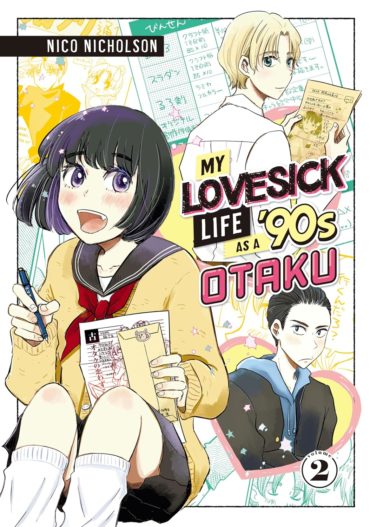My Lovesick Life as a ’90s Otaku Volume 2 Review
With Megumi’s passion for all things manga conflicting with her love for otaku-hating classmate Masamune, in this second volume we get to understand exactly where his hatred comes from.
This volume starts with Megumi and her out-and-proud otaku classmate Miko creating their own doujinshi to sell at the forthcoming Comiket. While getting some stationery, Megumi bumps into a woman cosplaying Lina Inverse from Slayers, who is working to draw customers to a bar. Not surprisingly, the two hit it off and become friendly immediately, but things change when Masamune passes by and tries to stop the cosplayer from acting weird. It turns out the cosplayer, whose name is Fujiko, is actually Masamune’s mother.
Megumi comes to discover that Fujiko’s devotion to anime and manga is so great that it comes at the expensive of the rest of the family. Masamune is the one who has to look after his younger siblings, and we later see him working in a butcher’s shop to make ends meet. Things become even more problematic when Megumi finds one of Masamune’s little sisters outside a clinic and has to help her.
Elsewhere, at Comiket, Megumi’s penpal Yui, whom Megumi still doesn’t know is a boy named Itokichi, comes to visit and buy her doujinshi, but he is still apprehensive about revealing his true identity to Megumi. At school meanwhile, the coach of Masamune’s basketball team, Ichika, begins to more openly display her dislike to Megumi when she overhears her talking about a band that she likes who recently provided the theme for an anime series. Things become heated, but we know they’ll eventually settle down because when we cut to the present day, we see that the adult Megumi and Ichika have become friendly.
In this second volume, the main area of interest is plot development. We finally get to see what appears to be the cause of Masamune’s hatred of otaku. Namely, his mother is one, and she devotes herself to her passion so much it has damaged the relationships in the family. As a result, it adds complexity to the relationship between him and Megumi, as she tries to figure out a way of truly expressing herself.
There are still plenty of references to 1990s series that will keep readers entertained. As well as Lina Inverse, we see Fujiko cosplaying Asuka from Evangelion. When Masamune tries to get her to pick up her kids, Fujiko says she can’t do it because Gundam Wing is on in five minutes. We also see references to Studio Ghibli, Rayearth, Yu Yu Hakusho and (sadly) Rurouni Kenshin.
Once again, the quality of the production of this series remains good, with Matt Treyvaud’s translation, Jamil Stewart’s lettering, and Maggie Lee’s editing all combining brilliantly to make an entertaining product. One editor’s note relating to currency conversion is particularly useful. You have probably seen in older manga prices being roughly converted from yen into US dollars, the conversion being about 1 yen to 1 cent. However, the note also manages to take inflation into account. When Megumi visits Miko’s place, she learns that Miko has a game console worth ¥49,800. The note reads: “In 1995, ¥49,800 would be $498. With inflation, that would be about $1,000 USD in 2023.” This is nice information to get – and for added context, $1,000 is about £800.
This second volume marks the half-way point in My Lovesick Life as a ‘90s Otaku, and it will be interesting to see how the story progresses. For one thing, if modern-day Megumi is catching up with her old friends, does that mean we will also meet the adult Masamune too?
Our review copy from Kodansha was supplied by Diamond Book Distributors UK.


